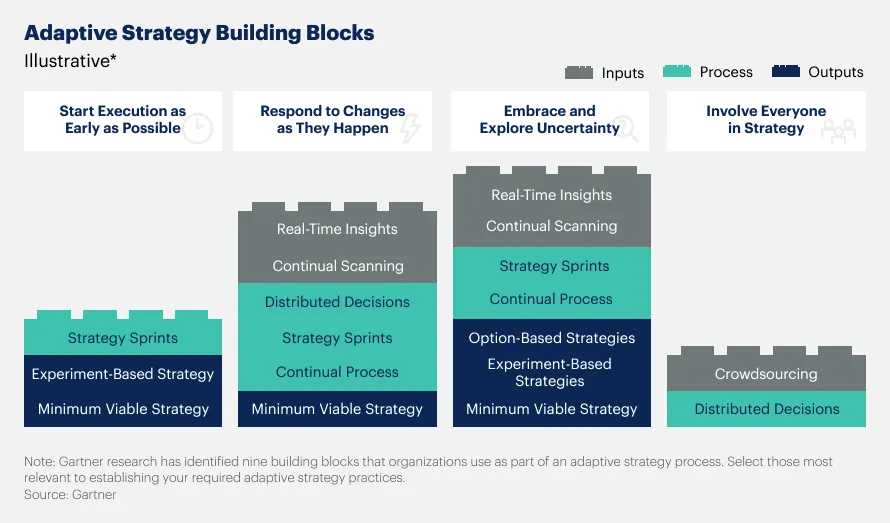Table of contents
Table of contents- Disruption on the Red Sea Puts Pressure on Global Supply Chains
- How does disruption in shipping routes impact global supply chains
- Suez Canal: a major logistics artery
- The knock-on effect on the supply chain
- Disruption in the Red Sea leads to price hike
- A resilient supply chain is essential
- Adaptive Strategy Building Blocks
- Seeking alternative solutions
How does disruption in shipping routes impact global supply chains
Disruptions in the supply chain follow in rapid succession. The aftermath of the errant cargo ship, Ever Given, which blocked the Suez Canal in Egypt for weeks in the spring of 2021, has barely subsided, and the next logistical nightmare at sea is already presenting itself.
Drones, piloted by Houthi forces from Yemen, are targeting several cargo ships in the Red Sea. The attacks are a consequence of Israel’s current conflict with Hamas, with Houthi rebels coming out in support of the Hamas regime. It creates an unsafe situation in perhaps the world’s most important shipping lane.
The looming situation in the Red Sea puts logistics carriers in a huge dilemma, forcing them to choose between the safety of their ships and delays in delivery time, with the added consequence of considerable extra costs.
The big question now is whether the situation will be a short-lived event or a long-term problem, as we are seeing this year in the Panama Canal. There, due to low water levels, ships have had to take much lengthier detour routes for months. What is clear is that shipping companies are bracing themselves for the far-reaching consequences of the current situation, which threatens to once again throw the entire logistics sector further out of balance.
Suez Canal: a major logistics artery
The shipping route along the western Yemen is part of the busy shipping route between Europe and Asia. It is the link between the Mediterranean Sea and the Red Sea and is visited by dozens of cargo ships every day. To illustrate this, one in every three containers transported by sea passes through this shipping route, of which the Suez Canal is perhaps the most famous stretch. Although the route is vulnerable – after all, we saw it in 2021 – shipping companies will always have a preference to use it. The alternative is to circumnavigate around Africa’s southernmost point, which easily adds up to some 5,000 extra kilometres.
Several international shipping companies (including MSC, Maersk and Evergreen) have already indicated that they will immediately avoid the route via Yemen, and thus the Suez Canal, in order to guarantee the safety of their ships.
The shipping companies that have already declared this measure are collectively responsible for about 60% of world trade. They are now opting for the alternative shipping route or even choosing to set up hybrid models that combine sea and air cargo, or sea and road transport. This has sizeable implications for the logistics sector.
The knock-on effect on the supply chain
Extended sea voyages around Africa add three to four weeks to the round trip from Europe to Asia. This is not only annoying in the short term, but will inevitably cause long-term reverberations globally.
Containers will not be at the right destination at the right time, so it will not be possible for newly scheduled cargoes to be transported in the planned containers.
This “capacity crunch” in turn will lead to further delays in the delivery of containers and goods. The goods ordered for the Christmas period were fortunately in place for entrepreneurs, but delivery times may suddenly become uncertain in the forthcoming post-Christmas period.
Orders placed without taking into account the extended delivery time will not be sufficient to cover expected demand.
This immediately raises the danger of stockouts, and customers are likely to have to wait longer for their orders because retail chains will be out-of-stock.
While customers may be able to understand the current situation, multiple delays, and/or no deliveries at all, will not be accepted. If entrepreneurs do not take timely action, they are likely to face the same problem more often.
The problem now emerging in the Red Sea may reverberate for a longer period of time, and the logistics sector will start noticing a domino effect in the supply chain process.
So, responding to current events now is the key to success that every entrepreneur needs to pick up on.
Disruption in the Red Sea leads to price hike
Buying the right amount of stock at the right time is becoming crucial for buyers. For pending orders, it is important to provisionally factor in a temporarily longer delivery time. After all, the containers that suppliers had planned to ship their freight in could arrive days, weeks, or in the worst case scenario, months later.
But it’s not just containers that are suddenly scarce; ships are also not in the right place at the right time either. Delays in deliveries of containers and raw materials are inevitable. And with that, the next problem presents itself. I’m talking about price increases. In fact, they are already visible now.
The current uncertainty in the Red Sea has already directly driven up sea freight costs. Since the start of the war between Israel and Hamas, prices for the Asia-East US transport route have already risen by 5% to $2,497 per sea container, freight booking platform, Freightos, has reported.
The ING banking group has also reported price increases. For instance, the price for transporting a standard 40ft sea container between Shanghai and Rotterdam was an average €1,063 at the end of November 2023; now it is €1,513 – over 40% higher.
With the recently announced course changes by the afore-mentioned shipping lines, there is a good chance that those costs will keep rising. A longer shipping route entails higher fuel costs, and because ships take longer to reach their destination, the diversions result in a perceived ‘ship capacity crunch’.
Peter Sand, Chief Analyst at Xeneta, a leading platform for benchmarking sea and air freight rates, reckons costs are skyrocketing.
“There is capacity in the market, but it comes at a price. Ocean freight rates could rise by 100 per cent. This is a cost that will eventually be passed on.”
With that, the possibility of price increases, lurks in the background. After all, insurers are already preparing for higher premiums, and business owners will also raise prices to maintain their profits.
Sand already points to the 2024 contract negotiations as an example. “The current situation may also affect the current negotiations between shippers and ocean carriers for long-term contracts for the duration of 2024. Carriers may be concerned that long-term rates in the market could rise dramatically as a result of this crisis.”
A resilient supply chain is essential
Watching the developments in the Red Sea from a distance is currently not enough for entrepreneurs if they want to continue offering their customers the service they are used to.
Automated and standard processes can come under pressure, so appropriate action is required to maintain service levels at the desired standard.
Organisations that can change plans quickly are as much as 198% more likely to realise the full potential of opportunities in the face of external events. This is according to Gartner’s recently released Strategy Adaptive Planning Survey.
Supply chain teams need to be able to respond competently to the current situation to be successful. However, Gartner’s research shows that only 38% of all business leaders say their business plans can change quickly enough to respond to changes in the market.
To illustrate this, Gartner has identified nine building blocks that organisations should use as part of an adaptable supply chain strategy.
Adaptive Strategy Building Blocks
What actions are you expected to take now?
Disruptions at sea (both the Red Sea and the Panama Canal) create uncertainty in the supply chain. From a planning perspective, actions will have to be taken to reduce supply chain risks, such as inventory shortages.
First steps to take:
Monitor which open purchase orders do not arrive on time
Chances are your placed orders will not arrive at your desired time. Rerouting or waiting for available containers will result in them arriving weeks later than planned.
Inventory: which items do you need to order in larger quantities?
To make sure you can meet your customer demand, your stock must be adequate. Therefore, it makes sense to check whether you need to temporarily buy more, given the longer delivery times. Adjusting delivery times (as in Slim4) results in a higher order recommendation, for example.
Seeking alternative solutions
There may be alternative suppliers who can supply you with your desired items. During the corona pandemic, many entrepreneurs were already looking for alternative suppliers and got creative by moving stock within their own network. The knowledge gained during this period can now be reapplied.
To be fully agile, we have written down five steps that entrepreneurs should follow to remain as flexible as possible in these turbulent times.
Step 1: Conduct research
Gather input from your procurement department to hear which suppliers are affected in terms of their location and the carriers they use. After all, not all carriers have yet decided to avoid the Red Sea. Others offer alternative routes by combining sea, air and road freight.
It is advisable to then convert this information into logical actions so that you know what suppliers do, do not, or no longer have a grip on. Your orders can be divided into three categories:
- Orders already ordered but not yet on their way.
- Orders already ordered, in transit, but not yet arrived at port.
- Orders for which you want to place an order soon.
Step 2: Assessing impact
This is the hardest step to take. It is advisable to plan at least two weeks ahead. What do you expect your stock to do during that time, and do you need to take additional actions?
Check regularly whether you can still move forward and how the situation in the Red Sea is developing. Would the intervention of the United States help restore safe and optimal navigation of the shipping lane so that calm would return? Or should you make other longer-term plans?
Step 3: Keep delivery times up-to-date and update scheduling parameters
Keeping a finger on the pulse is hugely important. Stay in touch with your suppliers so that you know the current delivery times of your ordered products.
Where normally it might have taken a week to get your order to its destination, it could now take five weeks. Shipping times might have increased fivefold, containers and ships may suddenly become unavailable. It’s important to set up your inventory to respond to longer delivery times, either by:
- Adding supplier reliability. This affects the lead time, safety stock and order level.
- Adding extra time to the total lead time. This affects the lead time and order level.
Step 4: Monitor exceptions and take corrective action where possible
Special situations require special measures. Look within your organisation to see what you have in hand that can be implemented immediately. For instance, move stock within your network where possible to solve problems. And/or place orders where possible with alternative suppliers closer to, or within, Europe.
Step 5: Keep monitoring
It is vital to keep a close eye on the situation. Should you stick to your alternative plans, or is your critical inventory problem now over? If the latter, it is advisable to return to familiar ordering patterns as soon as possible. After all, that is what business operations are built on.
In this time of uncertainty, a resilient supply chain is indispensable. With the above steps, companies can guard against supply chain disruptions and possibly even emerge stronger from them.
Stay agile, stay informed and steer your supply chain to success.







